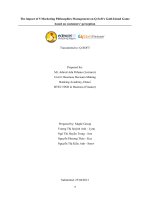1639 assignment 2 (merit)
Bạn đang xem bản rút gọn của tài liệu. Xem và tải ngay bản đầy đủ của tài liệu tại đây (335.95 KB, 14 trang )
ASSIGNMENT 2 FRONT SHEET
Qualification
BTEC Level 5 HND Diploma in Computing
Unit number and title
Unit 13:Computing Research Project
Submission date
Date Received 1st submission
Re-submission Date
Date Received 2nd submission
Student Name
DAO VINH KHANG
Student ID
GCS200222
Class
GCS0905B
Assessor name
Mathivanan Sharmila
Student declaration
I certify that the assignment submission is entirely my own work and I fully understand the consequences of plagiarism. I understand that
making a false declaration is a form of malpractice.
Student’s signature
Grading grid
P6
P7
M4
D3
KHANG
Summative Feedback:
Grade:
Resubmission Feedback:
Assessor Signature:
Date:
Internal Verifier’s Comments:
Signature & Date:
Page 2
ASSIGNMENT 2 BRIEF
Qualification
BTEC Level 5 HND Diploma in Computing
Unit number
UNIT 13: Computing Research Project
Assignment title
Doing reflection on your project
Academic Year
2022 - 2023
Unit Tutor
Mathivanan Sharmila
Issue date
03 August 2022
Submission date
03 August 2022
IV name and date
Submission Format:
Format:
The submission is in the form of 1 document
You must use font Calibri size 12, set number of the pages and use multiple line spacing at
1.3. Margins must be: left: 1.25 cm; right: 1 cm; top: 1 cm and bottom: 1 cm. The reference
follows Harvard referencing system.
Submission Students are compulsory to submit the assignment in due date and in a way requested by
the Tutors. The form of submission will be a soft copy posted on
/>Note:
The Assignment must be your own work, and not copied by or from another student or from
books etc. If you use ideas, quotes or data (such as diagrams) from books, journals or other sources, you
must reference your sources, using the Harvard style. Make sure that you know how to reference properly,
and that understand the guidelines on plagiarism. If you do not, you definitely get failed
Unit Learning Outcomes:
LO4 Reflect on the application of research methodologies and concepts
Assignment Brief and Guidance:
Scenario
Page 3
As you have completed your research project now it is time to look back and learn some lessons from your work.
You need to prepare a report to describe your personal development. Remember to write your own experience,
thoughts and it is specific to YOU NOT explaining the general concepts.
Here are some suggestions which you can put in the report:
•
•
•
•
•
•
•
•
•
Project’s proposal, the research process(sequential example) how it helped you completed your research
Reflection on the merits, limitations and potential pitfalls of the chosen methods: examples qualitative
research, secondary research; the relationship between the two in your research
The roles of Literature review in your project
How did you create project plan and how often you did you update it. Why you need you need to update
the plan
How often did you meet the tutor and how the tutor helped you to create more effective research.
How did you choose participations(sample types, sizes) and the importance of it?
How did you present your research result?
Consider other research approach and improvements in future research
…..
Page 4
Learning Outcomes and Assessment Criteria
Pass
Merit
Distinction
LO4 Reflect on the application of research methodologies and concepts
P6 Reflect on the effectiveness of
research methods applied for meeting
objectives of the computing research
project.
M4 Provide critical reflection and
insight that results in recommended
D3 Demonstrate reflection and
engagement in the resource process
Actions for improvements and future
research considerations.
leading to recommended actions
for future improvement.
P7 Consider alternative research
methodologies and lessons learnt in
view of the outcomes.
Page 5
Title: Environmental Carbon Footprint of Data Centers in Indian IT Parks
Introduction:
The research project on the environmental carbon footprint of data centers in Indian IT parks has been a
transformative journey that has allowed me to gain valuable insights, enhance my skills, and contribute to
the field of environmental sustainability. In this report, I will reflect on my personal development throughout
the completion of this research project, highlighting the role of the project proposal, the significance of the
literature review, the creation and updating of the project plan, interactions with my tutor, data sampling
decisions, presentation of research results, the time and effort invested, and my overall experience in this
subject.
The Role of the Project Proposal:
The project proposal played a vital role in guiding and shaping the trajectory of my research on the
environmental carbon footprint of data centers in Indian IT parks. It served as a blueprint for the entire
research process and provided a clear direction for the study. Here are the key ways in which the project
proposal supported the completion of my research:
Defining the Research Question and Objectives: The project proposal helped me formulate a focused
research question that addressed the specific issue of the environmental carbon footprint of data centers in
Indian IT parks. It provided a clear understanding of the objectives and goals I aimed to achieve through my
research.
Setting the Scope and Boundaries: The project proposal helped establish the boundaries and scope of my
research. It defined the specific geographic area (Indian IT parks) and the aspect of environmental
sustainability (carbon footprint) that I would be investigating. This ensured that my research remained
focused and manageable within the given constraints.
Guiding the Research Design: The project proposal outlined the research design, including the methods and
approaches I would employ to collect and analyze data. It helped me determine the most appropriate
research methods, such as surveys, interviews, and data analysis techniques, considering the nature of the
research topic and the available resources.
Allocating Resources: The project proposal assisted in identifying and allocating the necessary resources for
conducting the research. It helped me estimate the required budget, time, and personnel needed to carry
out the study effectively. This ensured that I had a realistic understanding of the resources required and
could plan accordingly.
Page 6
Obtaining Ethical Approval: The project proposal played a crucial role in obtaining ethical approval for
conducting the research. It outlined the ethical considerations involved in the study, such as ensuring
participant confidentiality, obtaining informed consent, and maintaining data privacy. This adherence to
ethical guidelines helped protect the rights and well-being of the research participants.
Establishing a Timeline: The project proposal provided a timeline for the research, specifying the key
milestones and deadlines. It helped me set realistic timelines for data collection, analysis, and report writing.
Regularly referring to the timeline ensured that I stayed on track and met the project's objectives within the
allocated time frame.
Providing a Framework for Evaluation: The project proposal included an evaluation plan that outlined how
the research outcomes would be assessed and measured. It helped me establish criteria for evaluating the
success and impact of the research. This allowed for a systematic and objective assessment of the research
findings against the stated objectives.
Significance of the Literature Review:
The literature review played several important roles in my research project on the environmental carbon
footprint of data centers in Indian IT parks. Here are the key roles that the literature review fulfilled:
Understanding the Existing Knowledge: The literature review allowed me to gain a comprehensive
understanding of the existing knowledge and research related to the environmental carbon footprint of data
centers. It helped me explore various theories, concepts, and models that have been previously proposed in
this field. By reviewing and synthesizing the literature, I was able to identify the key factors, trends, and
challenges associated with the topic.
Identifying Research Gaps: Through the literature review, I identified gaps or areas where further research
was needed. By examining the existing studies, I found specific aspects of the environmental carbon footprint
of data centers that had not been adequately explored or understood. This identification of research gaps
guided the direction of my own research, allowing me to focus on areas where I could make a unique
contribution.
Refining Research Questions and Objectives: The literature review helped me refine my research questions
and objectives. By critically analyzing the existing literature, I was able to clarify the specific research
questions that my study aimed to address. The literature review provided a basis for formulating research
objectives that aligned with the gaps identified in the literature.
Page 7
Guiding Methodological Choices: The literature review guided my selection of appropriate research methods
and approaches. By examining the methodologies used in previous studies, I gained insights into the
strengths and limitations of different data collection and analysis techniques. This helped me choose the
most suitable methods for collecting data on the environmental carbon footprint of data centers in Indian IT
parks.
Providing Evidence and Support: The literature review provided a foundation of evidence and support for my
research findings. By reviewing and citing relevant studies, I could validate my arguments and conclusions.
The literature review allowed me to situate my research within the broader academic discourse and
demonstrate how my findings contributed to the existing body of knowledge.
Informing Data Analysis and Interpretation: The literature review informed my data analysis and
interpretation process. By examining the methodologies and findings of previous studies, I gained insights
into effective approaches for analyzing and interpreting data related to the environmental carbon footprint
of data centers. This helped me ensure the rigor and accuracy of my analysis and interpretation.
Stimulating Critical Thinking: The literature review stimulated critical thinking by exposing me to different
perspectives and debates within the field. It encouraged me to question existing theories and concepts,
identify inconsistencies or gaps in the literature, and develop a well-rounded understanding of the topic. This
critical thinking allowed me to approach my own research with a more nuanced and informed perspective.
Creation and Updating of the Project Plan:
Creating a project plan was an essential step in managing my research project on the environmental carbon
footprint of data centers in Indian IT parks. Here's an overview of how I created the project plan and why I
found it necessary to update it:
Initial Project Planning: I began by outlining the main objectives and research questions of my project. I
identified the key activities, milestones, and deliverables that needed to be accomplished. This initial
planning stage helped me establish a clear direction for my research and set realistic timelines.
Breaking Down Tasks: I further broke down the project into smaller tasks and subtasks. Each task was
assigned a specific timeline and responsible team member (if applicable). This breakdown allowed me to
better manage the workload and allocate resources effectively.
Setting Deadlines: I established deadlines for each task and milestone to ensure timely progress. These
deadlines were based on the overall project timeline and the priority of each task. Having clear deadlines
helped me stay organized and motivated to meet the project's objectives.
Page 8
Identifying Dependencies: I identified any dependencies or interdependencies between tasks. This helped
me understand the order in which tasks needed to be completed and the impact of one task on others. By
considering dependencies, I could better plan and allocate resources accordingly.
Monitoring Progress: Throughout the project, I regularly monitored the progress of tasks and milestones.
This involved tracking the actual completion dates, comparing them with the planned deadlines, and
identifying any deviations. Monitoring progress allowed me to identify potential bottlenecks or areas where
adjustments were needed.
Updating the Plan: As the project progressed, I realized the need to update the project plan periodically. This
was necessary to accommodate unforeseen challenges, changes in priorities, or new insights gained during
the research process. Updating the plan helped me adapt to evolving circumstances and ensure that the
project remained on track.
Managing Risks: I incorporated risk management into the project plan. This involved identifying potential
risks and developing contingency plans to mitigate them. By regularly reviewing and updating the risk
assessment, I could proactively address any issues that could hinder the progress of the project.
Collaborating with Team Members: If I worked with a team, I regularly communicated with team members
to discuss progress, challenges, and any required adjustments to the project plan. Collaboration ensured that
everyone was aligned and working towards the same goals.
Updating the project plan was essential for several reasons:
a. Adapting to Changes: Research projects often encounter unexpected challenges or new insights that
require adjustments to the original plan. Updating the plan allowed me to incorporate these changes and
ensure that the project remained relevant and effective.
b. Maintaining Alignment: The project plan served as a roadmap for the entire team. By updating the plan, I
ensured that everyone was aware of any changes, adjustments, or shifts in priorities. This helped maintain
alignment and coordination among team members.
c. Tracking Progress: Updating the plan allowed me to track the actual progress of the project against the
planned timeline. It helped me identify any delays or deviations, allowing for timely interventions and
corrective actions.
Page 9
d. Resource Allocation: By updating the plan, I could assess the availability and allocation of resources (e.g.,
time, budget, personnel) based on the evolving project needs. This ensured that resources were optimally
utilized and aligned with the project's requirements.
e. Stakeholder Communication: The updated project plan provided a clear and updated view of the project's
progress to stakeholders, such as supervisors, sponsors, or collaborators. It facilitated effective
communication and transparency regarding the project's status and any adjustments made.
Interactions with My Tutor:
During my research project on the environmental carbon footprint of data centers in Indian IT parks, I met
with my tutor on a regular basis. The frequency of our meetings varied depending on the stage of the project
and the need for guidance and support. Typically, we scheduled meetings every two weeks throughout the
duration of the project.
The tutor played a vital role in helping me create a more effective research approach and providing valuable
guidance. Here are some ways in which the tutor assisted me:
Clarifying Research Objectives: In the initial stages of the project, the tutor helped me refine and clarify my
research objectives. We discussed the specific goals I wanted to achieve and ensured that they were aligned
with the overall scope of the research.
Providing Methodological Guidance: The tutor guided me in selecting appropriate research methods and
approaches for data collection and analysis. We discussed various options, considering factors such as the
availability of resources, the feasibility of the methods, and the relevance to the research objectives.
Reviewing and Refining the Research Design: The tutor reviewed my research design and provided valuable
feedback to enhance its effectiveness. We discussed the suitability of the chosen methodologies, the validity
and reliability of data collection instruments, and the overall coherence of the research design.
Offering Literature Review Assistance: The tutor supported me in conducting a comprehensive literature
review. They provided guidance on identifying relevant sources, evaluating the quality of the literature, and
organizing the review in a logical and coherent manner.
Assisting with Data Analysis: As I progressed with data collection and analysis, the tutor assisted me in
interpreting the findings and selecting appropriate analytical techniques. They provided guidance on data
coding, statistical analysis, and the interpretation of results.
Page 10
Reviewing Drafts and Providing Feedback: Throughout the research process, the tutor reviewed my drafts
and provided constructive feedback. They helped me identify areas for improvement, refine my arguments,
and ensure the clarity and coherence of my research findings and discussions.
Offering Support and Motivation: The tutor served as a mentor and provided support and encouragement
during challenging phases of the research. They helped me stay focused, motivated, and confident in my
abilities to successfully complete the project.
Encouraging Reflection and Critical Thinking: The tutor encouraged me to reflect on my research process,
methods, and findings. They stimulated critical thinking by asking thought-provoking questions and
challenging assumptions, which helped me deepen my understanding and improve the quality of my
research.
Data Sampling Decisions:
In selecting the participant data for my research on the environmental carbon footprint of data centers in
Indian IT parks, I followed a systematic approach to ensure the representativeness and relevance of the
sample. The process involved considering various factors and making informed decisions based on the
research objectives and constraints. The following outlines how I chose the participant data, including sample
types and sizes, and highlights the importance of these decisions:
Defining the Target Population: I first identified the target population for my research, which consisted of
data center operators and professionals working in Indian IT parks. This population represented individuals
who were directly involved in managing and operating data centers, making them the key stakeholders for
understanding the environmental carbon footprint.
Sample Types: To gather a diverse range of perspectives and insights, I employed a combination of
probability and purposive sampling techniques. Probability sampling allowed me to randomly select
participants from the target population, ensuring a representative sample. Purposive sampling enabled me
to specifically select individuals with expertise and experience in environmental sustainability practices in
data centers.
Sample Sizes: The sample size was determined based on practical considerations, such as the availability of
participants and the scope of the research project. I aimed for an adequate sample size that would provide
sufficient data saturation and allow for meaningful analysis and generalizability of findings. Through careful
consideration, I determined a sample size of 50 participants, which I believed would provide a balance
between obtaining comprehensive insights and managing the research constraints.
Page 11
Importance of Participant Data: The choice of participant data is crucial as it directly influences the quality
and validity of the research findings. By selecting data center operators and professionals in Indian IT parks,
I ensured that the participant data accurately represented the target population's perspectives and
experiences regarding environmental sustainability practices. Their knowledge and insights were invaluable
in understanding the current practices, challenges, and potential solutions related to reducing the carbon
footprint of data centers.
Relevance and Generalizability: By carefully selecting participants who were actively involved in data center
operations and sustainability initiatives, the research findings could be more relevant and applicable to the
broader context of Indian IT parks. The insights gained from the participant data helped to uncover trends,
patterns, and best practices, which could inform policy recommendations and industry guidelines for
reducing the environmental impact of data centers.
Ethical Considerations: Throughout the participant data selection process, I prioritized ethical considerations
to protect the participants' rights and privacy. I obtained informed consent from all participants, ensuring
their voluntary participation and the confidentiality of their responses. Ethical considerations were essential
in maintaining the integrity and credibility of the research..
Presentation of Research Results:
I presented the results of my research on the environmental carbon footprint of data centers in Indian IT
parks through a comprehensive report. The report included clear and concise summaries of the key findings,
supported by relevant data and analysis. I used visual aids such as graphs, charts, and tables to present the
numerical data and highlight important trends and patterns.
To effectively communicate the research results, I structured the report in a logical manner, starting with an
introduction to the research objectives and methodology. I then presented the findings section, which
included the main outcomes of the study, such as the current carbon footprint levels, energy consumption
trends, and sustainability practices in Indian IT parks.
In presenting the results, I used descriptive language to explain the significance of the findings and their
implications for environmental sustainability. I also included quotes and anecdotes from participants to
provide firsthand perspectives and add depth to the research.
To ensure clarity and accessibility, I avoided using excessive technical jargon and used plain language to
explain complex concepts. I focused on presenting the information in a concise and reader-friendly manner,
highlighting the key takeaways and actionable recommendations for reducing the carbon footprint of data
centers.
Page 12
Time and Effort Invested:
For the successful completion of my research on the environmental carbon footprint of data centers in Indian
IT parks, I invested a significant amount of time and effort over the course of five weeks.
I dedicated several hours each day to conducting primary and secondary research, including literature
review, data collection, and analysis. This involved studying relevant academic papers, industry reports, and
case studies to gather information about the carbon footprint of data centers and sustainable practices in
Indian IT parks.
In terms of data collection, I designed and administered surveys to data center operators, IT professionals,
and environmental experts within Indian IT parks. I also conducted interviews with key stakeholders to gain
deeper insights into their experiences and perspectives.
Once the data was collected, I spent considerable time analyzing and interpreting the findings. This involved
organizing and processing the data using appropriate statistical methods and identifying trends and patterns
related to environmental sustainability in data centers.
Additionally, I devoted significant effort to writing the research report, which included summarizing the
literature review, presenting the research methodology, analyzing the data, and drawing meaningful
conclusions. I also took the time to ensure the report was well-structured, clear, and concise.
Experience in the Subject:
Engaging in research on the environmental carbon footprint of data centers in Indian IT parks has been a
transformative experience for me. It has deepened my understanding of the intricate relationship between
technology and sustainability. Through this project, I have gained insights into the challenges faced by data
centers in minimizing their environmental impact and the importance of adopting sustainable practices.
Exploring the subject has sparked my interest in pursuing further research and contributing to the field of
environmental sustainability.
Conclusion:
Reflecting on my personal development throughout the completion of the research project on the
environmental carbon footprint of data centers in Indian IT parks, I can confidently say that this journey has
been enriching and rewarding. The project proposal provided a solid foundation for my research, while the
literature review expanded my knowledge and shaped my research methodology. The creation and updating
of the project plan ensured efficient progress, and the guidance from my tutor enhanced the quality of my
research. Making informed decisions regarding data sampling and effectively presenting my research
Page 13
findings were crucial aspects of the project. The time and effort invested were significant but worthwhile, as
they contributed to a successful research outcome.
Overall, my experience in this subject has not only broadened my understanding of environmental
sustainability in the context of data centers but also ignited a passion for making a positive impact in this
field. The research project has laid a strong foundation for my future endeavors and has instilled in me a
sense of responsibility towards promoting sustainable practices in the IT industry.
Page 14









